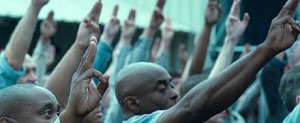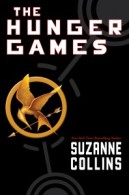At a local middle school, a special event has been announced and it is an inter-grade competition with a Hunger Games theme. At an all-school meeting last week, teachers explained that for that one afternoon, each grade would become a district, be assigned a color and would compete against each other in friendly challenges of knowledge, speed, endurance and teamwork. Names of volunteers from each grade would be drawn from a bag to compete in each challenge for a set number of points and to earn even more, the District (grade) who had the most students come to school that day in their assigned color would win a huge bonus. The grade that won the whole event would get an ice cream party. Following this announcement, the gym erupted in noise: the seventh grade chanted “District. Seven.” over and over, I heard yells of “I volunteer as tribute” and students all over the gym raised three fingers and whistled four familiar notes.
 After our discussion of critical literacies over the past few weeks, I have been thinking a lot about the ways in which schools can step outside the box to further these literacies. The Hunger Games event at this middle school was not focused on any kind of traditional literacy, and really only came about as a way to engage the entire student body for two hours while the majority of teachers were in a meeting. The remaining teachers ran with this opportunity and the Hunger Games-themed event was born. Never having read the Hunger Games trilogy (I know, I know, it’s on my reading list), I am not in an ideal position to be touting the benefits of utilizing it in literacy instruction. However, feeling the energy in the gym that day, I saw the ways in which, with some careful planning, the awesome power of those students’ love for the trilogy could be channeled into some amazing teaching opportunities.
After our discussion of critical literacies over the past few weeks, I have been thinking a lot about the ways in which schools can step outside the box to further these literacies. The Hunger Games event at this middle school was not focused on any kind of traditional literacy, and really only came about as a way to engage the entire student body for two hours while the majority of teachers were in a meeting. The remaining teachers ran with this opportunity and the Hunger Games-themed event was born. Never having read the Hunger Games trilogy (I know, I know, it’s on my reading list), I am not in an ideal position to be touting the benefits of utilizing it in literacy instruction. However, feeling the energy in the gym that day, I saw the ways in which, with some careful planning, the awesome power of those students’ love for the trilogy could be channeled into some amazing teaching opportunities.
It is true that students who had not read the books may feel marginalized by the theme of the event and until the event has take place, I will not know whether the goals set by the teachers were met. However, what the experience brought home for me was that sincere excitement and energy can be used in creating an authentic and fun learning environment. I know this is not news. Teachers have been using favorite books, films and other forms of popular culture to support instruction for a long time. It makes sense to connect to students’ lives and interests to engage in abiding learning. I had simply never seen that idea implemented on such a large scale and be greeted with such widespread enthusiasm.
I guess my question is what are other books, movies or television shows that we can use to further learning and support the development of critical literacies in school? Should we even be expending energy trying to create projects based around popular culture or is it likely to be a distraction to students, rather than a gateway to learning? I am inclined to think that engaging in literacy instruction using Harry Potter, for example, would help students connect their learning to something they are genuinely interested in: fostering excitement, not limiting their creativity. Books like those in the Harry Potter series and the Hunger Games trilogy are controversial for a variety of reasons, but they are also extremely popular with students. Educators have to balance potential push-back and the opportunity to engage students in these exciting ways.
For more on beloved books and literacy… (mostly with adolescents)
Arter, L. (2009). Celebrating Multiple Literacies with Harry Potter. English Journal, 98(6), 69-73.
Curwood, J., Magnifico, A., & Lammers, J. C. (2013). Writing in the Wild: Writers’ Motivation in Fan-Based Affinity Spaces. Journal Of Adolescent & Adult Literacy, 56(8), 677-685.
Fingon, J. C. (2012). Nontraditional Texts and the Struggling/Reluctant Reader. Voices From The Middle, 19(4), 70-75.
Sass-Henke, A. (2012). Putting Characters First in a Middle School Classroom. English Journal, 102(1), 71-75.
Simmons, A. M. (2012). Class on Fire: Using the Hunger Games Trilogy to Encourage Social Action. Journal Of Adolescent & Adult Literacy, 56(1), 22-34.
Urbach, J., & Eckhoff, A. (2012). Release the Dragon: The Role of Popular Culture in Children’s Stories. Contemporary Issues In Early Childhood, 13(1), 27-37.
Images from:
http://www.fandango.com/movie-news/12-days-of-hunger-games-giveaways-whom-would-you-salute-711510
http://www.buzzfeed.com/ashleybaccam/international-harry-potter-book-covers#1p5ypt7


What a neat thing to witness! I enjoyed reading your reflection and thoughts. I now wish my school held something akin to a Hunger Games special event with the whole school. My school is full of adorable nerds, and I know they would love it. It sounds enriching and engaging.
I think the use of popular media is crucial in both building culture and community and also increasing student interest and motivation, so I think you’re on the right track to look for what’s out there. I think the Divergent Series by Veronica Roth might have a lot to offer middle school students in terms of critical literacy teaching. From my understanding critical literacy encompasses multiculturalism and consideration of multiple perspectives. In the Divergent series there are different factions which each value unique character traits. Starting with the Divergent world as a parallel, you can help students examine the ways in which multiple perspectives manifest and conflict and also illustrate how multiple views can be defended. Additionally, examining how the main character Tris is able to better understand others through her adoption of multiple perspectives might help students see the value in this type of thinking.
LikeLike
I have not read The Hunger Games either. I saw the first movie and found it stupid (but my high schoolers this summer said it was my own fault because the movie leaves out sooo much from the book. apparently I am wrong about it being stupid). I would be curious to know how this event played out.
LikeLike
Wow! That school really went all in on the Hunger Games. I wish I could’ve seen it! I LOVE that series and while I was excited reading about the activities, part of me was tentative, worried about pitting students against each other in mimicry of such a violent event [the actual Games, I mean, not the book]. Although, I’m sure I’m not giving teens enough credit–they can separate fiction from reality.
With that preamble you would never guess that I am 100% PERCENT behind using pop culture to engage students. So, to answer your question, YES, we should be expending energy to create projects based around popular culture–it provides that all-important connection to something that they are interested in [reminds me of graphic novels, actually]. When the project is built around a phenomenon as multi-layered as The Hunger Games, all the better. I wonder if any of the teachers [before or after this event] used The HG as a springboard to other discussions of literacy, power, privilege, poverty, social inequities, media, etc? What a wonderful opportunity for collaboration across subjects–English, Social Studies, and Art come to mind, first.
There is so much in those trilogies to spark discussion and several anthologies of critical essays, including The Girl on Fire [written by YA authors], could guide lesson construction/discussions. Very cool!
LikeLike
Sorry, title is The Girl Who Was on Fire [forgot the ‘was’].
LikeLike